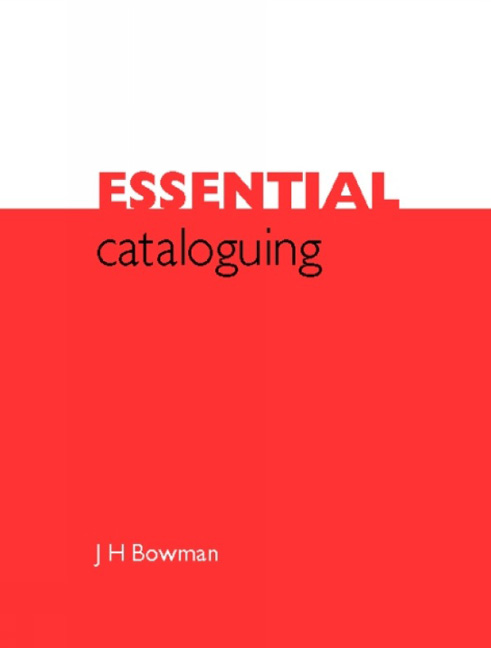Book contents
- Frontmatter
- Contents
- Note to this impression
- Acknowledgements
- 1 Introduction
- 2 Background to cataloguing and AACR2
- 3 Structure of AACR2 and of the MARC 21 format
- 4 Description
- 5 Access points
- 6 Multipart works
- 7 Headings for persons
- 8 Headings for corporate bodies
- 9 Authority control
- 10 Uniform titles
- Bibliography
- Appendix: Catalogue records in MARC 21 format for the examples in this book
- Index
- Frontmatter
- Contents
- Note to this impression
- Acknowledgements
- 1 Introduction
- 2 Background to cataloguing and AACR2
- 3 Structure of AACR2 and of the MARC 21 format
- 4 Description
- 5 Access points
- 6 Multipart works
- 7 Headings for persons
- 8 Headings for corporate bodies
- 9 Authority control
- 10 Uniform titles
- Bibliography
- Appendix: Catalogue records in MARC 21 format for the examples in this book
- Index
Summary
AACR2 Chapter 1 is designed to help you to describe any kind of material, including kinds that have not yet been invented. It is therefore written in rather general terms. To see how to deal with a specific physical form of material, look at Chapters 2–12, e.g. for printed books see AACR2 Chapter 2. But each of those chapters will keep referring you back to Chapter 1 for fuller information. You therefore really need to have a finger in Chapter 1 as you look at the rules in whichever chapter is relevant. Now that AACR2 has been issued in loose-leaf format it is easier to compare sections if you need to. To start with we shall stick to Chapter 1 as it gives the fullest information.
Areas of description
The description is organized into a series of ‘areas’, as follows:
Title and statement of responsibility
Edition
Material (or type of publication) specific details
Publication, distribution, etc.
Physical description
Series
Note
Standard number and terms of availability
The order in which these areas appear cannot vary, and you will soon become familiar with this order. Not all of them are compulsory: several only appear when they are needed, and otherwise you can just ignore them. There is no need to show a blank space or anything like that; just miss them out. We shall see what is necessary as we go along.
Sources of information
The most important thing to get clear in your mind is that, whatever kind of material you are cataloguing, you are only allowed to take information from certain places in the item, and that the places you are allowed to use vary depending on which area of the description you are dealing with. If you can remember this you are halfway to being a good cataloguer.
Each chapter of AACR2 starts with a list of the areas and the prescribed sources of information, as they are called, for that specific physical form of publication.
As an example, this means that, for the Title and statement of responsibility area of a book, you may take information only from the title page, whereas for the Edition area you have a greater range of sources.
- Type
- Chapter
- Information
- Essential Cataloguing , pp. 20 - 85Publisher: FacetPrint publication year: 2003

